The air flow sensors market stands at the threshold of a decade-long expansion trajectory that promises to reshape automotive sensing technology and environmental monitoring solutions. The market's journey from USD 2.5 billion in 2025 to USD 3.5 billion by 2035 represents substantial growth, demonstrating the accelerating adoption of advanced sensing technology and precision air flow measurement across automotive applications, HVAC systems, industrial facilities, and medical device operations.
The first half of the decade (2025-2030) will witness the market climbing from USD 2.5 billion to approximately USD 2.9 billion, adding USD 0.4 billion in value, which constitutes 40% of the total forecast growth period. This phase will be characterized by the rapid adoption of mass air flow sensor systems, driven by increasing automotive electrification and the growing need for advanced emission control solutions worldwide. Enhanced sensing capabilities and automated calibration systems will become standard expectations rather than premium options.
The latter half (2030-2035) will witness continued growth from USD 2.9 billion to USD 3.5 billion, representing an addition of USD 0.6 billion or 60% of the decade's expansion. This period will be defined by mass market penetration of MEMS-based sensing technologies, integration with comprehensive building management platforms, and seamless compatibility with existing automotive and HVAC infrastructure. The market trajectory signals fundamental shifts in how automotive manufacturers and facility operators approach air flow measurement and efficiency management, with participants positioned to benefit from growing demand across multiple sensing technologies and application segments.
Automotive manufacturing operations encounter emissions compliance pressures between regulatory requirements and production efficiency demands. Engine development teams need air flow sensors that meet EPA certification requirements for vehicle emissions control while maintaining performance characteristics across varying operating conditions, but production engineers focus on sensor cost optimization and supply chain reliability over regulatory validation complexity.
Quality assurance departments require air flow sensors with documented calibration for emissions testing compliance, while assembly line operations prefer standardized sensor installations that minimize production variations and testing protocols. Environmental compliance coordinators specify sensor accuracy requirements for regulatory approval, but manufacturing management resists sensor modifications that could affect production schedules or increase validation costs.
Chemical processing operations encounter safety monitoring challenges when implementing flow sensors for hazardous atmosphere detection. Process safety engineers need air flow sensors for ventilation monitoring that ensure safe working conditions while maintaining process control accuracy, but production supervisors focus on sensor systems that integrate with existing control infrastructure without process disruptions. Safety compliance teams require flow sensors with intrinsically safe designs for hazardous area classification, while maintenance technicians need sensor systems that accommodate process environment conditions without frequent replacement. Risk management coordinators specify flow sensor performance for process safety management compliance, but operations teams resist monitoring additions that could complicate process control or increase system complexity.
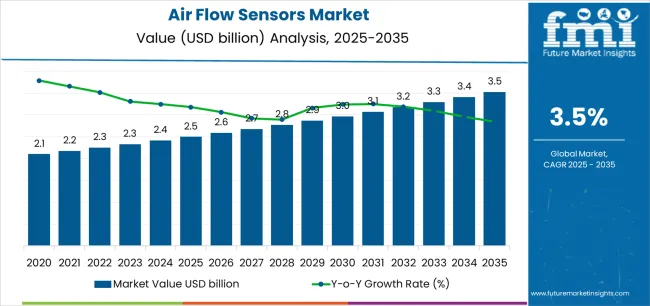
| Period | Primary Revenue Buckets | Share | Notes |
|---|---|---|---|
| Today | Automotive OEM sensors (MAF, intake monitoring) | 48% | Emission compliance-driven, vehicle production-linked |
| HVAC & building automation sensors | 22% | IAQ monitoring, energy efficiency optimization | |
| Replacement & aftermarket sensors | 15% | Automotive replacement, maintenance cycles | |
| Industrial & process monitoring | 10% | Cleanrooms, semiconductor fabs, food processing | |
| Medical device integration | 5% | Ventilators, CPAP devices, anesthesia systems | |
| Future (3-5 yrs) | Automotive electrification sensors | 40-44% | EV battery cooling, hydrogen fuel cells, thermal management |
| Smart building & IAQ monitoring | 24-28% | Real-time air quality, energy optimization, occupancy sensing | |
| Digital sensor platforms | 12-16% | IoT connectivity, predictive maintenance, analytics | |
| Medical & healthcare devices | 8-12% | Advanced ventilation, respiratory monitoring, portable devices | |
| Industrial automation & cleanrooms | 8-10% | Semiconductor manufacturing, precision process control | |
| Aftermarket & retrofit solutions | 6-8% | Building upgrades, vehicle sensor replacement |
| Metric | Value |
|---|---|
| Market Value (2025) | USD 2.5 billion |
| Market Forecast (2035) | USD 3.5 billion |
| Growth Rate | 3.5% CAGR |
| Leading Technology | Mass Air Flow (MAF) Sensors |
| Primary Application | Automotive Segment |
The market demonstrates strong fundamentals with mass air flow sensor systems capturing a dominant share through advanced precision measurement capabilities and automotive emission optimization. Automotive applications drive primary demand, supported by increasing emission regulations and vehicle electrification requirements. Geographic expansion remains concentrated in Asia Pacific with established automotive manufacturing infrastructure, while emerging economies show accelerating adoption rates driven by localization initiatives and rising environmental standards.
Design for accuracy, not just range
Primary Classification: The market segments by product type into mass air flow (MAF) sensors and volume air flow (VAF) sensors, representing the evolution from basic flow measurement equipment to sophisticated sensing solutions for comprehensive automotive and HVAC optimization.
Secondary Classification: Application segmentation divides the market into automotive, HVAC & building systems, industrial/process applications (including cleanrooms, semiconductors, food & beverage, pharmaceutical), medical/healthcare (ventilators, CPAP, anesthesia), and other niches (data centers, laboratories, instruments), reflecting distinct requirements for measurement accuracy, response time, and operational environment standards.
Tertiary Classification: Sensing technology segmentation covers MEMS hot-film/hot-wire, thermal anemometer (non-MEMS), and differential pressure/ultrasonic & other methods, while end-use scenarios span automotive manufacturers, building operators, industrial facilities, and medical device companies.
Regional Classification: Geographic distribution covers Asia Pacific, North America, Europe, Middle East & Africa, and Latin America, with developed markets leading adoption while emerging economies show accelerating growth patterns driven by automotive manufacturing expansion and building automation programs.
The segmentation structure reveals technology progression from standard flow measurement equipment toward sophisticated digital sensing systems with enhanced accuracy and connectivity capabilities, while application diversity spans from automotive facilities to medical device operations requiring precise air flow measurement solutions.
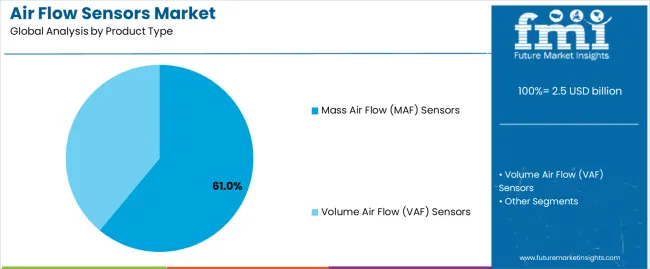
Market Position: Mass air flow sensor systems command the leading position in the air flow sensors market with 61% market share through advanced measurement features, including superior accuracy, operational reliability, and automotive emission optimization that enable manufacturers to achieve optimal engine performance across diverse automotive and industrial environments.
Value Drivers: The segment benefits from automotive manufacturer preference for reliable sensing systems that provide consistent mass flow measurement, precise air-fuel ratio control, and emission compliance optimization without requiring significant infrastructure modifications. Advanced design features enable automated temperature compensation systems, humidity correction, and integration with existing engine management equipment, where operational performance and regulatory compliance represent critical application requirements.
Competitive Advantages: Mass air flow sensor systems differentiate through proven operational reliability, consistent measurement characteristics, and integration with automated engine control systems that enhance vehicle effectiveness while maintaining optimal emission standards suitable for diverse automotive and industrial applications.
Key market characteristics:
Volume air flow sensor systems maintain a 39% market position in the air flow sensors market due to their cost-effective measurement properties and simplicity advantages. These systems appeal to applications requiring basic flow monitoring with competitive pricing for standard automotive and HVAC scenarios. Market growth is driven by building automation expansion, emphasizing reliable sensing solutions and operational efficiency through optimized system designs.
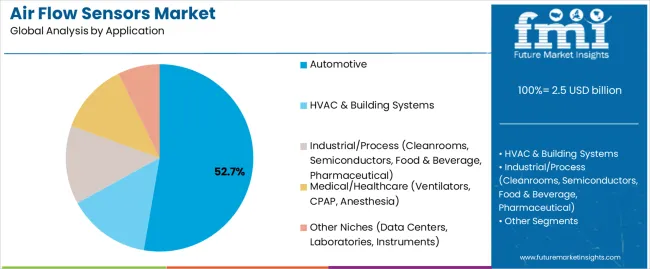
Market Context: Automotive applications dominate the market with 52.7% market share, reflecting the primary demand source for air flow sensor technology in engine management and emission control operations.
Business Model Advantages: Automotive manufacturers provide direct market demand for advanced sensing equipment, driving technology innovation and emission compliance while maintaining performance optimization and fuel efficiency requirements.
Operational Benefits: Automotive applications include gasoline engine management, diesel emission control, and electric vehicle thermal management that drive consistent demand for sensing equipment while providing access to latest measurement technologies.
HVAC & building systems applications capture 21% market share through indoor air quality requirements in commercial facilities, residential buildings, and smart building installations. These facilities demand accurate flow sensing systems capable of optimizing energy consumption while providing effective ventilation monitoring and environmental control capabilities.
Industrial and process applications account for 15.3% market share, including cleanroom monitoring in semiconductor facilities, pharmaceutical manufacturing, food & beverage processing, and precision manufacturing operations requiring controlled air flow capabilities for quality assurance and process optimization.
Medical and healthcare applications hold 8.5% market share through essential sensing requirements in ventilators, CPAP devices, anesthesia delivery systems, and respiratory monitoring equipment. These applications demand ultra-precise flow measurement systems capable of ensuring patient safety while providing reliable performance in critical care scenarios.
Other niche applications account for 2.5% market share, including data center cooling optimization, laboratory instrumentation, analytical equipment, and specialized industrial instruments requiring precise air flow measurement capabilities for operational optimization.
Market Context: MEMS hot-film and hot-wire technology demonstrates the highest market share in the air flow sensors market with 64% market position due to widespread adoption of miniaturized sensing systems and increasing focus on automotive emission optimization, manufacturing cost efficiency, and precision measurement applications that maximize sensor performance while maintaining compact form factor standards.
Appeal Factors: MEMS technology operators prioritize sensor miniaturization, manufacturing scalability, and integration with existing automotive and HVAC infrastructure that enables coordinated sensing operations across multiple system applications. The segment benefits from substantial semiconductor investment and microfabrication capabilities that emphasize the acquisition of MEMS systems for performance optimization and cost-efficiency applications.
Growth Drivers: Automotive electrification programs incorporate MEMS sensors as standard components for thermal management operations, while building automation growth increases demand for compact sensing capabilities that comply with space constraints and minimize installation complexity.
Market Challenges: Varying contamination exposure and particle sensitivity may limit sensor durability across different environments or application scenarios.
Application dynamics include:
Thermal anemometer (non-MEMS) systems capture 23% market share through established measurement requirements in industrial facilities, laboratory applications, and high-accuracy installations. These facilities demand proven sensing technologies capable of operating in diverse conditions while providing effective flow measurement and calibration stability capabilities.
Differential pressure, ultrasonic, and other sensing methods account for 13% market share, including specialized measurement requirements in harsh environments, bidirectional flow applications, and high-temperature installations requiring alternative sensing principles for operational reliability and measurement accuracy.
| Category | Factor | Impact | Why It Matters |
|---|---|---|---|
| Driver | Emission regulations & fuel efficiency standards (Euro 7, EPA Tier 3, China 6) | ★★★★★ | Stringent emission norms require precise air-fuel ratio control; MAF sensors become mandatory for compliance and optimal combustion efficiency. |
| Driver | Automotive electrification & thermal management (EVs, battery cooling) | ★★★★★ | Electric vehicles need thermal control for batteries and power electronics; hydrogen fuel cells require precise air flow measurement for stack performance. |
| Driver | Indoor air quality standards & smart buildings (ASHRAE, LEED, WELL) | ★★★★☆ | IAQ regulations mandate ventilation monitoring; smart buildings integrate flow sensors for energy optimization and occupant health. |
| Restraint | Price sensitivity & commoditization pressure (especially automotive aftermarket) | ★★★★☆ | Cost competition reduces margins; aftermarket price erosion and sensor commoditization limit premium positioning opportunities. |
| Restraint | Contamination sensitivity & calibration drift (particulate exposure, humidity) | ★★★☆☆ | Automotive and industrial environments cause sensor fouling; maintenance requirements and calibration drift increase total cost of ownership. |
| Trend | IoT integration & predictive maintenance | ★★★★★ | Digital connectivity, real-time monitoring, and cloud analytics transform operations; smart sensors with diagnostic capabilities become competitive differentiators. |
| Trend | Medical device innovation & portable healthcare | ★★★★☆ | Home healthcare growth and portable ventilators require miniaturized, accurate sensors; COVID-19 accelerated respiratory monitoring demand. |
The air flow sensors market demonstrates varied regional dynamics with Growth Leaders including India (4.3% growth rate) and China (3.9% growth rate) driving expansion through automotive manufacturing initiatives and smart building development. Steady Performers encompass United States (3.7% growth rate), Japan (3.6% growth rate), and developed regions, benefiting from established automotive industries and advanced emission control adoption. Emerging Markets feature South Korea (3.5% growth rate) and developing regions, where automotive technology initiatives and industrial modernization support consistent growth patterns.
Regional synthesis reveals Asian markets leading adoption through automotive production expansion and building automation development, while North American countries maintain steady expansion supported by emission regulation advancement and smart building standardization requirements. European markets show moderate growth driven by premium automotive applications and building energy efficiency integration trends.
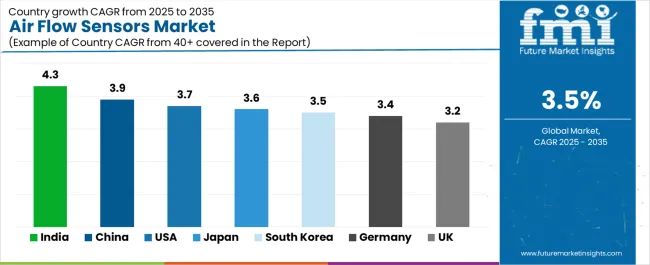
| Region/Country | 2025-2035 Growth | How to win | What to watch out |
|---|---|---|---|
| India | 4.3% | Focus on localized production and cost-effective solutions | Infrastructure variability; price competition |
| China | 3.9% | Lead with EV thermal management sensors | Localization mandates; domestic competition |
| United States | 3.7% | Provide emission compliance packages | Regulatory complexity; aftermarket pricing pressure |
| Japan | 3.6% | Offer precision hybrid/EV sensors | Over-specification; lengthy validation cycles |
| South Korea | 3.5% | Push semiconductor cleanroom solutions | Technology refresh cycles; concentrated customer base |
| Germany | 3.4% | Premium automotive and Industry 4.0 integration | Euro 7 compliance costs; factory retrofit complexity |
| United Kingdom | 3.2% | Net-zero building and healthcare focus | Brexit impacts; hospital budget constraints |
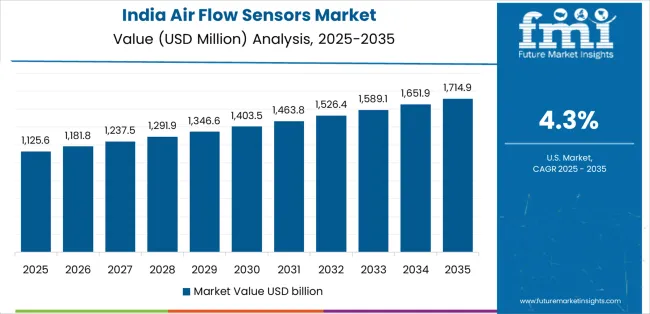
India establishes fastest market growth through aggressive automotive manufacturing programs and comprehensive smart city development, integrating advanced air flow sensors as standard components in vehicle production and building automation installations. The country's 4.3% growth rate reflects government initiatives promoting automotive localization, Make in India programs, and domestic manufacturing capabilities that mandate the use of advanced sensing systems in automotive and HVAC facilities. Growth concentrates in major automotive hubs, including Chennai, Pune, and Gurugram, where automotive technology development showcases integrated sensor systems that appeal to manufacturers seeking advanced emission control capabilities and indoor air quality applications.
Indian manufacturers are developing cost-effective sensing solutions that combine domestic production advantages with advanced operational features, including digital output capabilities and enhanced measurement accuracy. Distribution channels through automotive component suppliers and building automation distributors expand market access, while government support for Bharat Stage VI emission standards and smart city missions supports adoption across diverse automotive and HVAC segments.
Strategic Market Indicators:
In Beijing, Shanghai, and Shenzhen, automotive facilities and manufacturing plants are implementing advanced air flow sensors as standard equipment for emission control and thermal management applications, driven by increasing government environmental investment and electrification programs that emphasize the importance of precision measurement capabilities. The market holds a 3.9% growth rate, supported by government China 6 emission initiatives and EV development programs that promote advanced sensing systems for automotive and industrial facilities. Chinese operators are adopting sensor systems that provide consistent measurement performance and emission compliance features, particularly appealing in urban regions where air quality and environmental standards represent critical operational requirements.
Market expansion benefits from growing electric vehicle manufacturing capabilities and cleanroom expansion agreements that enable domestic production of advanced sensor systems for automotive and semiconductor applications. Technology adoption follows patterns established in automotive electronics, where reliability and cost-effectiveness drive procurement decisions and operational deployment.
Market Intelligence Brief:
United States establishes market leadership through comprehensive emission regulation programs and advanced automotive technology development, integrating air flow sensors across automotive and building automation applications. The country's 3.7% growth rate reflects established automotive industry relationships and mature sensing technology adoption that supports widespread use of precision measurement systems in vehicle and HVAC facilities. Growth concentrates in major automotive centers, including Detroit, California, and Texas, where automotive technology showcases mature sensor deployment that appeals to manufacturers seeking proven emission control capabilities and energy efficiency applications.
American equipment providers leverage established distribution networks and comprehensive service capabilities, including calibration programs and technical support services that create customer relationships and operational advantages. The market benefits from mature regulatory standards and EPA requirements that mandate sensor system upgrades while supporting technology advancement and operational optimization.
Market Intelligence Brief:
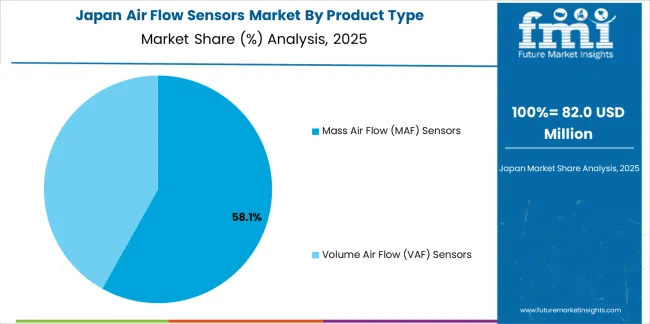
Japan's advanced automotive technology market demonstrates sophisticated air flow sensor deployment with documented operational effectiveness in hybrid vehicle applications and precision HVAC systems through integration with existing powertrain systems and manufacturing infrastructure. The country leverages engineering expertise in automotive electronics and precision manufacturing to maintain a 3.6% growth rate. Industrial centers, including Toyota City, Yokohama, and Osaka, showcase premium installations where sensor systems integrate with comprehensive hybrid powertrain platforms and robotics facility management systems to optimize combustion operations and environmental effectiveness.
Japanese manufacturers prioritize sensor precision and quality standards in sensing equipment development, creating demand for premium systems with advanced features, including facility integration and automated diagnostic systems. The market benefits from established automotive technology infrastructure and a willingness to invest in advanced sensing technologies that provide long-term operational benefits and compliance with stringent emission standards.
Market Intelligence Brief:
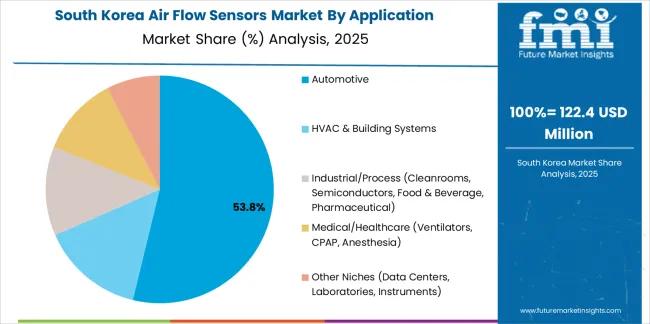
South Korea's market expansion benefits from diverse technology demand, including semiconductor cleanroom facilities in Seoul and data center developments, automotive manufacturing upgrades, and government hydrogen economy programs that increasingly incorporate sensor solutions for process control applications. The country maintains a 3.5% growth rate, driven by rising technology activity and increasing recognition of sensing technology benefits, including precise flow control and enhanced process efficiency.
Market dynamics focus on high-precision sensor solutions that meet semiconductor manufacturing requirements and thermal management standards important to Korean technology operators. Growing cleanroom industrialization creates continued demand for advanced sensing systems in semiconductor fabrication infrastructure and data center cooling projects.
Strategic Market Considerations:
Germany's advanced automotive technology market demonstrates sophisticated air flow sensor deployment with documented operational effectiveness in premium vehicle applications and industrial facilities through integration with existing engine management systems and factory automation infrastructure. The country leverages engineering expertise in automotive technology and Industry 4.0 systems to maintain a 3.4% growth rate. Industrial centers, including Stuttgart, Munich, and Wolfsburg, showcase premium installations where sensor systems integrate with comprehensive powertrain platforms and facility management systems to optimize combustion operations and factory effectiveness.
German manufacturers prioritize system precision and EU compliance in sensor equipment development, creating demand for premium systems with advanced features, including digital communication integration and automated diagnostic systems. The market benefits from established automotive technology infrastructure and a willingness to invest in advanced sensing technologies that provide long-term operational benefits and compliance with Euro 7 emission standards.
Market Intelligence Brief:
United Kingdom's market expansion benefits from diverse application demand, including net-zero building code implementations in London and healthcare facility upgrades, automotive emission improvements, and government decarbonization programs that increasingly incorporate sensor solutions for energy monitoring applications. The country maintains a 3.2% growth rate, driven by building regulation requirements and increasing focus on indoor air quality benefits, including ventilation optimization and enhanced occupant health.
Market dynamics focus on building code-compliant sensor solutions that meet ventilation monitoring requirements and healthcare standards. Growing life-science industrialization creates continued demand for precision sensing systems in hospital upgrade infrastructure and pharmaceutical facility modernization projects.
Strategic Market Considerations:
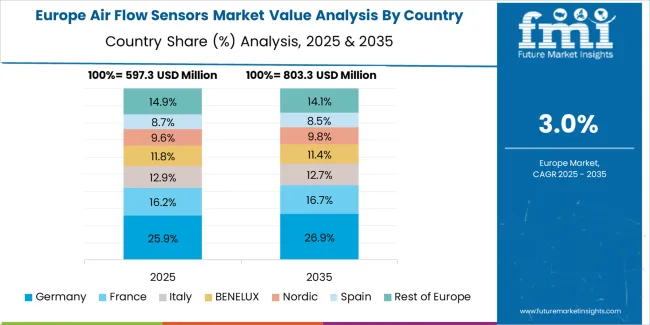
The air flow sensors market in Europe is projected to grow from USD 0.7 billion in 2025 to USD 0.9 billion by 2035, registering a CAGR of 3% over the forecast period. Germany is expected to maintain its leadership position with a 24% market share in 2025, declining slightly to 23.5% by 2035, supported by its advanced automotive technology infrastructure and premium vehicle manufacturing centers.
United Kingdom follows with a 18% share in 2025, projected to reach 18.5% by 2035, driven by comprehensive net-zero building programs and healthcare facility modernization initiatives. France holds a 15% share in 2025, expected to reach 15.3% by 2035 through specialized automotive applications and building energy compliance requirements. Italy commands a 12% share, while Spain accounts for 9% in 2025. The Nordic region is anticipated to maintain a 10% share, while Benelux holds 7% and the Rest of Europe region collectively represents 5% in 2025, expanding to 5.2% by 2035, attributed to increasing sensor adoption in emerging automotive facilities and building automation projects implementing modernization programs across Eastern European countries.
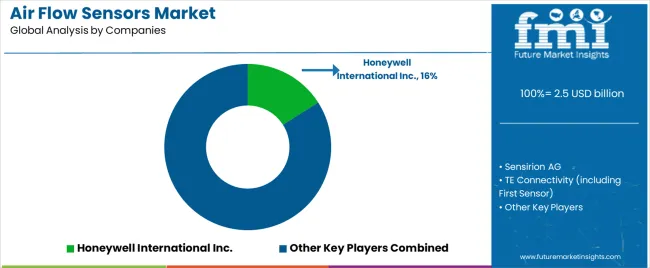
| Stakeholder | What they actually control | Typical strengths | Typical blind spots |
|---|---|---|---|
| Global platforms | Automotive OEM relationships, extensive product portfolios, global distribution | Multi-application support, proven reliability, comprehensive offerings | Technology refresh speed; emerging market penetration |
| Technology innovators | MEMS R&D capabilities; miniaturized sensors; digital communication protocols | Latest features first; strong IP portfolio; premium positioning | Service networks outside core regions; cost competitiveness |
| Regional specialists | Local automotive supply chains, rapid delivery, nearby technical support | Close-to-customer service; pragmatic pricing; regional compliance | Technology gaps; talent retention in R&D teams |
| Service-focused ecosystems | Calibration services, replacement programs, diagnostic software | Lowest total cost of ownership; comprehensive support packages | Service costs if over-promised; inventory management complexity |
| Niche specialists | Specialized applications, medical devices, cleanroom solutions | Win specialized segments; regulatory expertise; flexible customization | Scalability limitations; narrow market focus |
| Item | Value |
|---|---|
| Quantitative Units | USD 2.5 billion |
| Product Type | Mass Air Flow (MAF) Sensors, Volume Air Flow (VAF) Sensors |
| Application | Automotive, HVAC & Building Systems, Industrial/Process (Cleanrooms, Semiconductors, Food & Beverage, Pharmaceutical), Medical/Healthcare (Ventilators, CPAP, Anesthesia), Other Niches (Data Centers, Laboratories, Instruments) |
| Sensing Technology | MEMS Hot-Film/Hot-Wire, Thermal Anemometer (Non-MEMS), Differential Pressure/Ultrasonic & Other Methods |
| Regions Covered | Asia Pacific, North America, Europe, Middle East & Africa, Latin America |
| Countries Covered | India, China, United States, Japan, South Korea, Germany, United Kingdom, France, Italy, Australia, and 25+ additional countries |
| Key Companies Profiled | Honeywell International Inc., Sensirion AG, TE Connectivity, Denso Corporation, Bosch Sensortec GmbH, Omron Corporation, Amphenol Advanced Sensors, Analog Devices, Inc., STMicroelectronics, and Nippon Denso Manufacturing Co. |
| Additional Attributes | Dollar sales by product type and sensing technology categories, regional adoption trends across Asia Pacific, North America, and Europe, competitive landscape with automotive sensor manufacturers and building automation suppliers, automotive operator preferences for measurement accuracy and emission control, integration with engine management platforms and building control systems, innovations in MEMS technology and miniaturization enhancement, and development of digital sensing solutions with enhanced performance and IoT connectivity capabilities. |
The global air flow sensors market is estimated to be valued at USD 2.5 billion in 2025.
The market size for the air flow sensors market is projected to reach USD 3.5 billion by 2035.
The air flow sensors market is expected to grow at a 3.5% CAGR between 2025 and 2035.
The key product types in air flow sensors market are mass air flow (maf) sensors and volume air flow (vaf) sensors.
In terms of application, automotive segment to command 52.7% share in the air flow sensors market in 2025.






Our Research Products

The "Full Research Suite" delivers actionable market intel, deep dives on markets or technologies, so clients act faster, cut risk, and unlock growth.

The Leaderboard benchmarks and ranks top vendors, classifying them as Established Leaders, Leading Challengers, or Disruptors & Challengers.

Locates where complements amplify value and substitutes erode it, forecasting net impact by horizon

We deliver granular, decision-grade intel: market sizing, 5-year forecasts, pricing, adoption, usage, revenue, and operational KPIs—plus competitor tracking, regulation, and value chains—across 60 countries broadly.

Spot the shifts before they hit your P&L. We track inflection points, adoption curves, pricing moves, and ecosystem plays to show where demand is heading, why it is changing, and what to do next across high-growth markets and disruptive tech

Real-time reads of user behavior. We track shifting priorities, perceptions of today’s and next-gen services, and provider experience, then pace how fast tech moves from trial to adoption, blending buyer, consumer, and channel inputs with social signals (#WhySwitch, #UX).

Partner with our analyst team to build a custom report designed around your business priorities. From analysing market trends to assessing competitors or crafting bespoke datasets, we tailor insights to your needs.
Supplier Intelligence
Discovery & Profiling
Capacity & Footprint
Performance & Risk
Compliance & Governance
Commercial Readiness
Who Supplies Whom
Scorecards & Shortlists
Playbooks & Docs
Category Intelligence
Definition & Scope
Demand & Use Cases
Cost Drivers
Market Structure
Supply Chain Map
Trade & Policy
Operating Norms
Deliverables
Buyer Intelligence
Account Basics
Spend & Scope
Procurement Model
Vendor Requirements
Terms & Policies
Entry Strategy
Pain Points & Triggers
Outputs
Pricing Analysis
Benchmarks
Trends
Should-Cost
Indexation
Landed Cost
Commercial Terms
Deliverables
Brand Analysis
Positioning & Value Prop
Share & Presence
Customer Evidence
Go-to-Market
Digital & Reputation
Compliance & Trust
KPIs & Gaps
Outputs
Full Research Suite comprises of:
Market outlook & trends analysis
Interviews & case studies
Strategic recommendations
Vendor profiles & capabilities analysis
5-year forecasts
8 regions and 60+ country-level data splits
Market segment data splits
12 months of continuous data updates
DELIVERED AS:
PDF EXCEL ONLINE
Automotive Air Flow Sensors Market Size and Share Forecast Outlook 2025 to 2035
Airflow Balancer Market Size and Share Forecast Outlook 2025 to 2035
Air Flow Monitoring System Market
Airbag Sensors Market
Aircraft Sensors Market - Market Outlook 2025 to 2035
Laminar Airflow Trolley Market Size and Share Forecast Outlook 2025 to 2035
Laminar Airflow Cabinet Market Size and Share Forecast Outlook 2025 to 2035
Wireless Flow Sensors Market Analysis & Forecast by Technology, Application, and Region Through 2035
Horizontal Air Flow Condensers Market Size and Share Forecast Outlook 2025 to 2035
Automotive Air Flow Meter Market Size and Share Forecast Outlook 2025 to 2035
Electric Aircraft Sensors Market Size and Share Forecast Outlook 2025 to 2035
Electric Aircraft Onboard Sensors Market Size and Share Forecast Outlook 2025 to 2035
Automotive Cabin Air Quality Sensors Market Size and Share Forecast Outlook 2025 to 2035
Demand for Electric Aircraft Sensors in UK Size and Share Forecast Outlook 2025 to 2035
Air Fryer Paper Liners Market Size and Share Forecast Outlook 2025 to 2035
Air Struts Market Size and Share Forecast Outlook 2025 to 2035
Airless Paint Spray System Market Size and Share Forecast Outlook 2025 to 2035
Flower Box Market Size and Share Forecast Outlook 2025 to 2035
Air Caster Skids System Market Size and Share Forecast Outlook 2025 to 2035
Airborne Molecular Contamination Control Services Market Forecast and Outlook 2025 to 2035

Thank you!
You will receive an email from our Business Development Manager. Please be sure to check your SPAM/JUNK folder too.
Chat With
MaRIA